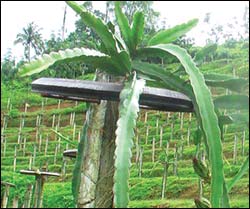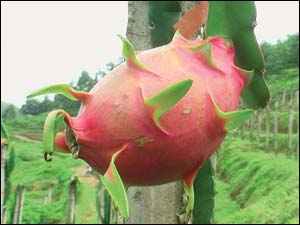Crop diversification by RPCs
Watawala Plantations, has become the first Regional Plantation
Company (RPC) to initiate commercial dragon fruit cultivation in Sri
Lanka, said the Planters’ Association of Ceylon in a press release.
|

A Dragon Fruit tree |
The dragon fruit venture is located at Homadola estate, in the Galle
district. The estate has adopted multi-cropping as an alternative to
traditional plantation cultivation style and dragon fruit is the latest
addition to the estate’s list of crop varieties.
“We initiated the dragon fruit cultivation in 2008 because it is
gaining popularity in Sri Lanka and South Asian countries. We are the
first plantation to start dragon fruit cultivation on a commercial
scale,” said Homadola estate Senior Manager Gamini Ratnayake.
By now the estate has four acres of dragon fruit cultivation. This is
in addition to its list of crops that include the traditional tea,
rubber and coconut cultivation, and other crops like oil palm,
pineapple, cinnamon, banana, citrus, macadamia and vanilla. The estate
says this multi-cropping system has a number of benefits, including
diversification of risk and providing more consistent employment for
estate communities. The multi-cropping system allows for year round
employment and the opportunity for higher wages.
The dragon fruit, a pinkish oval shaped fruit with a faceted exterior
and a white creamy pulp, is a fruit of the cactus species. The plant is
native to Mexico and Central and South American countries, but is also
cultivated in Asian countries. The fruit is also commonly known by the
names Pitaya and strawberry pear. A somewhat unusual feature of the
plant, is that it blooms only at night, producing a large, white,
fragrant flower, called the moonflower or queen of the night.
The dragon fruit takes approximately two-and-a-half years to harvest
from the time of planting. The initial cost per plant is about Rs 2,000.
This cost is seen as easily recoverable.
|

A Dragon Fruit |
“It is possible to cover costs and break even in about five years.
The lifetime of the plant is about 25 years. So there is a lot of scope
for cost recovery,” said Ratnayake.
Homadola estate has just harvested its second crop of dragon fruit
and says it already has a good market for it. Currently the dragon fruit
supply to the local market is limited, and commands a high price of
around Rs 400 per kilo.
“There is a demand for the fruit from hotels in the south and we also
supply to the Colpetty market. With growth in tourism we expect the
demand to increase,” Ratnayake said.
Homadola estate says it hopes to further develop the dragon fruit
project over the coming years to increase estate profitability. |



